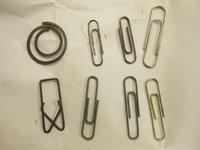
Open your desk drawer, and most likely you have a collection of paper clips – those you bought and the paper clips you pull off of the papers that come into your office every day.
Frank McClung at BLANK has a thoughtful blog about paper clips and the symbolism that has become associated with them, and it reminded me that I have a paper clip collection.
That is, I thought I had a paper clip collection. What I really have is a motley assortment of paper clips folded up in a piece of paper, since I seem to have a peculiar fascination with this twisted piece of wire. My assortment includes an Ezeon Paper Clip (lower left), a Nifty (upper left), and various size classic GEM paper clips.
What fascinates me about paper clips is that they are an innovation our of the industrial revolution – when it became possible to bend wire using machinery in a cost-effective manner:
Why weren't bent-wire paper clips marketed earlier? According to Petroski, "Steel wire was still new in the second half of the nineteenth century....[T]he widespread manufacture and use of the paper clip had to await not only the availability of the right wire but also the existence of machinery capable of tirelessly and reliably bending it in a flash into things that could be bought for pennies a box." (Henry Petroski, "From Pins to Paper Clips," The Evolution of Useful Things, Vintage, New York, 1992, p. 60)One of may favorite chairs (another peculiar fascination) is the Wassily Chair designed by Marcel Bruer. The tubular metal steel became affordable to manufacture, and the design is symbolic of this period of modernist design in furniture and architecture.
We attach our own symbolism to the simplest of things too: consider how a piece of pink ribbon or a yellow wristband have come to symbolize cancer awareness. This symbolism is most powerful when it has a cultural awareness associated with it – the greater the number of individuals who are familiar with the symbol and its association, the more effective the symbol.
To me, the Wassily chair represents a powerful era in design, but to my friends who see it, it represents a very uncomfortable-looking sitting machine.
To a designer, creating symbols requires that we have a broad view of culture and/or our audience, an understanding of what will communicate with them most effectively. We also need to use visual symbols that are all part of our common visual vocabulary (not a new idea... Paul Rand has much to say on this in Design, Form, and Chaos
A simplified explanation of how symbols work? Yes, but I have to keep looking for the rest of my paper clip collection.
I know it's here somewhere.
1 comment:
Hello,
I am writing from COLORS Magazine. The next issue COLORS 80: Collector is entirely devoted to collectors around the world and we would like to possibly feature somebody who collects your amazing View Finder Reels. I was very impressed by your collection. Ideally I need someone that is enthusiastic and I could interview and photograph. We are very excited about this project and the fact that we are showcasing global collectors with extremely varied 'jewels'. feel free to connect to our website which is http://lab.colorsmagazine.com/collector. You can direct any of the members of your association to it and they can upload their stuff and make contacts. I think it is a great opportunity for your you to be featured in this international magazine.
Ok, waiting anxiously for your reply and suggestions. Feel free to write me any questions or doubts.
Best wishes,
Carlos Mustienes
Editor/COLORS Magazine
COLORS - COLLECTOR
Fridges, wheels, nails, plastic bags...
Obsession, love and addiction are very human traits.
But what happens when objects become an obsession?
COLORS is preparing an issue on COLLECTOR, and we want your photographs, videos and stories. We're looking for stories about people who collect the strangest things, for the strangest reasons. As ever, the very best stories will be published in COLORS.
write me at
carlos @ globaldiscoball.com
Post a Comment